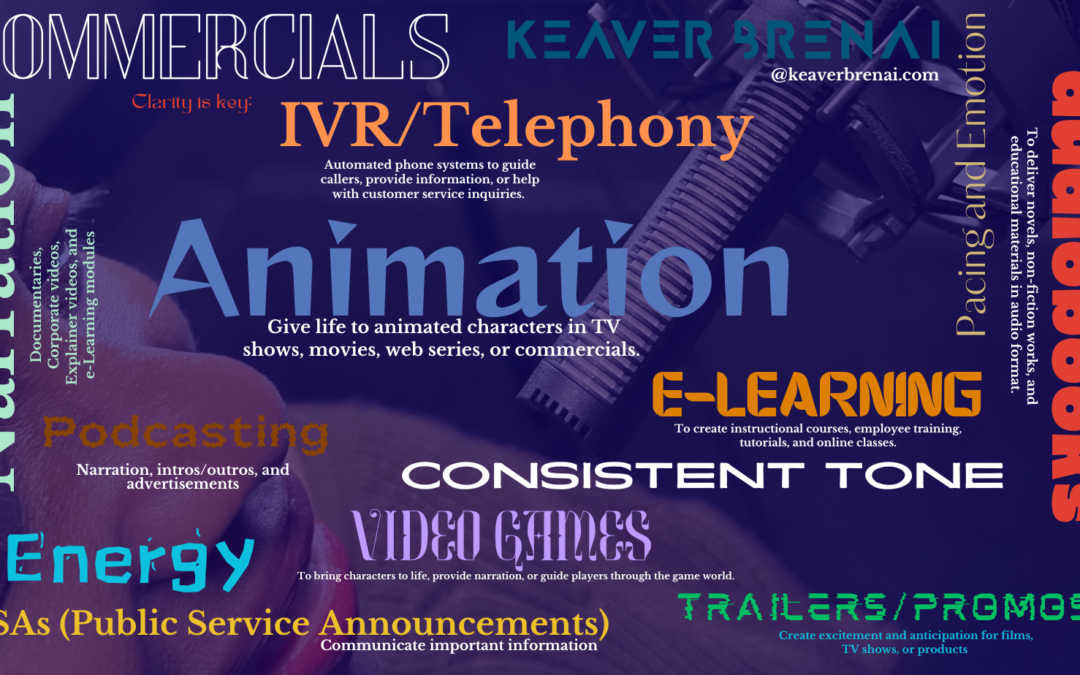Master the Art of Voiceover: Essential Tips for Every Genre
Welcome to the dynamic world of voiceover! Whether you’re a budding voice artist or a seasoned pro, mastering different genres is crucial for elevating your craft. In this blog, we explore the top 10 voiceover genres, detailing how clients utilize them and sharing best practices tailored for voiceover artists.
Commercials: Engage Your Audience
Usage: Voiceovers in commercials promote products, services, or brands on radio, TV, and online platforms.
Best Practices: Aim for a conversational tone that feels natural and relatable. Adjust your delivery to match the product’s tone, whether upbeat or soothing, and ensure your pacing keeps listeners hooked without rushing through.
Narration: Tell the Story
Usage: Narration finds its place in documentaries, corporate videos, explainer videos, and e-learning modules.
Best Practices: Clarity is your top priority because our voice must convey complex information in an engaging manner. Keep your delivery consistent and engaging to prevent listener fatigue.
Audiobooks: Bring Characters to Life
Usage: Audiobook voice artists narrate novels, non-fiction, and educational materials.
Best Practices: Differentiate characters distinctly and adjust your pacing to match the book’s emotional tone. Another practice is to ensure you maintain your vocal health during long recording sessions.
E-Learning: Educate and Inform
Usage: E-learning voiceovers guide learners through educational content in online classes and tutorials.
Best Practices: Be clear and articulate, giving learners time to absorb information. Another key point, your tone should be patient and supportive, especially when tackling complex topics.
Video Games: Create Immersive Worlds
Usage: In video games, voice acting brings characters and narratives to life.
Best Practices: Develop a deep understanding of each character’s backstory and emotions. Basically, be versatile in your ability to portray various characters and surprisingly emotional states.
IVR/Telephony: The Voice of Customer Service
Usage: IVR and telephony voiceovers are the first point of contact in customer service phone systems.
Best Practices: Ensure clarity and professionalism allowing you to master the art of voiceover. Your tone should be welcoming and warm, providing a friendly customer service experience.
Animation: Animate Your Voice
Usage: Voiceover in animation powers characters in TV shows, movies, and commercials.
Best Practices: Embrace exaggerated emotions to match animated personalities. Time your delivery to sync with the character’s actions.
Trailers and Promos: Build Anticipation
Usage: Trailers and promos use voiceovers to generate excitement for upcoming releases.
Best Practices: Deliver with dramatic intensity and pace your speech to align with the fast-paced nature of trailers, adapting to different genres as needed.
Podcasting: Connect with Listeners
Usage: Podcasts utilize voiceovers for narration, ads, and segment transitions.
Best Practices: Keep your tone natural and conversational, establishing a warm connection with your audience. Maintain consistent energy throughout the podcast to keep listeners engaged.
PSAs: Deliver Important Messages
Usage: Public service announcements rely on voiceovers to relay critical information to the public.
Best Practices: Use an authoritative yet empathetic tone to ensure clarity and sincerity and encourage public action on important issues.
Master the art of voiceover and the nuances of each voiceover genre is key to a successful career in the industry. By understanding client needs and applying genre-specific best practices, you can deliver compelling performances that resonate with audiences and satisfy client expectations.
Want to elevate your voiceover skills? Apply these expert tips to your next project and make your mark in the voiceover world!
Call to Action: Remember to wash your hands. And mask up. Follow me for more great tips!
Subscribe to our blog here for more tips and information.



Recent Comments